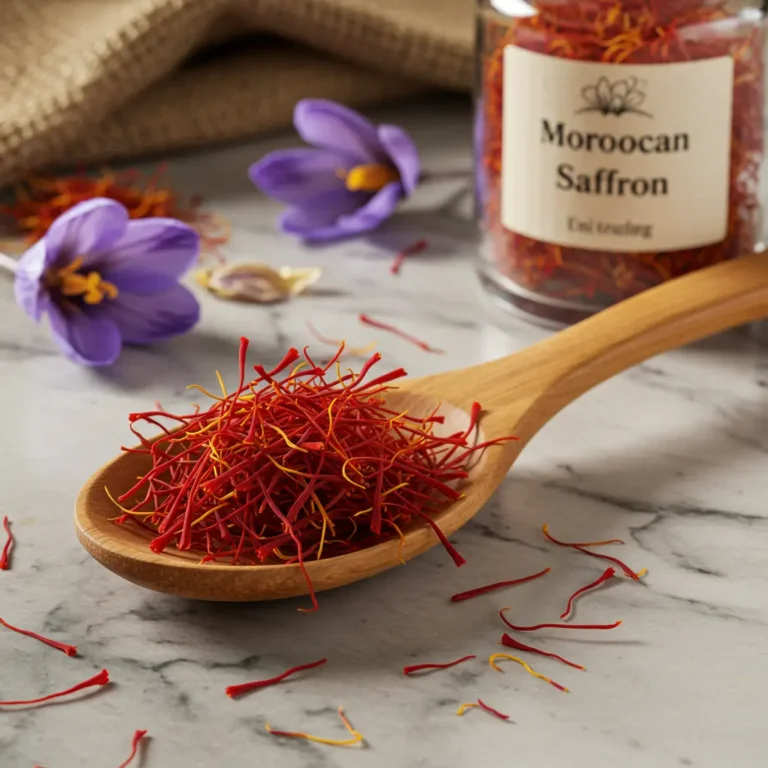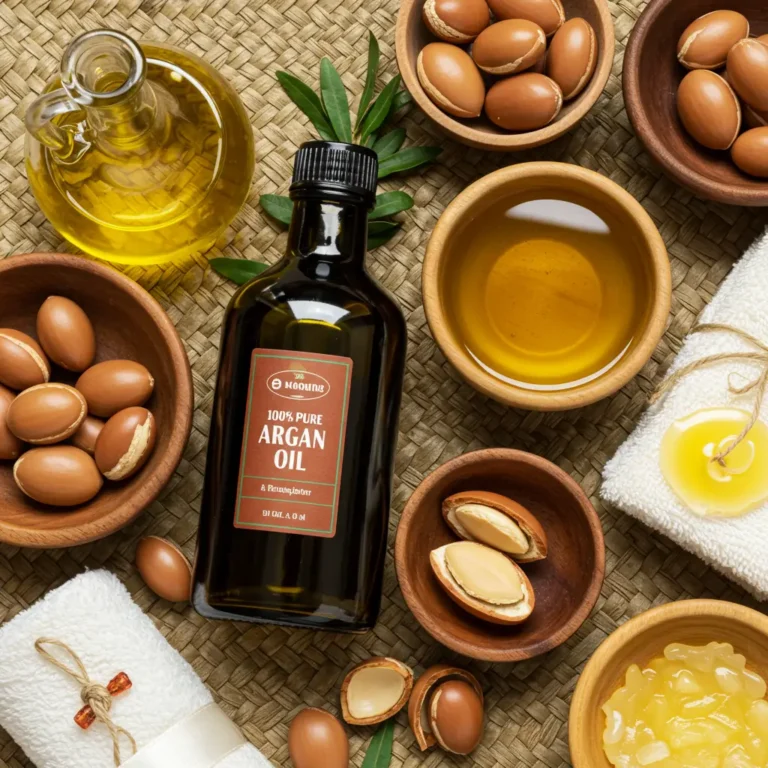Authentic Chermoula Sauce Moroccan Recipe
Let’s be honest—chermoula (charmoula) sauce isn’t just a condiment; it’s a quiet ritual in Moroccan kitchens. It’s the smell that seeps into terracotta walls on a Friday morning. It’s the greenish-red stain on a grandmother’s wooden pestle. It’s that first bite of marinated fish that feels like coming home, even if you’re far away.
In Morocco, we don’t measure chermoula in tablespoons—we measure it in memories.
If you’re here looking for the best authentic Moroccan chermoula sauce recipe, you’re in the right place. This is not a Mediterranean twist, not a fusion invention. This is the recipe — passed down, reimagined, and grounded in generations of flavor.
You’ll learn:
- Exactly what goes into a classic Moroccan chermoula (and why each ingredient matters)
- How to adapt it based on region, from Fes to the Souss Valley
- How to use it like we do in real Moroccan homes: with fish, tagines, potatoes, or even warm bread
- And why this simple, herb-heavy sauce deserves a permanent spot in your kitchen — no matter where you live
This isn’t about impressing guests with exotic flavors. This is about reconnecting with something timeless.
So grab your garlic, your cilantro, and let’s bring some soul back into the sauce.
Table of Contents
NuNutrition Information (Per Serving – ~2 Tbsp / 30 g)
This bright chermoula sauce isn’t just flavorful—it’s also surprisingly light and nutrient-rich.
Based on a standard recipe with olive oil, fresh herbs, garlic, and lemon, here’s the approximate nutritional breakdown per two‑tablespoon serving, estimated from similar recipes:
- Calories: ~90 kcal
- Total Fat: ~9 g (mostly from heart‑healthy olive oil)
- Sodium: ~250 mg (varies depending on salt and preserved lemon)
- Carbohydrates: ~3 g
- Protein: ~1 g
- Sugar: ~1 g
- Dietary Fiber: ~1 g
- Vitamin C: ~30% DV (thanks to lemon and herbs)
- Iron: ~6% DV
A similar estimate from Kaiser Permanente’s nutrition database lists 90 Calories, 9 g fat, 3 g carbs, 1 g protein, 1 g sugar, and 1 g fiber for a 2‑Tbsp serving of chermoula-style sauce .
Sources: 10healthy.kaiserpermanente.org
Is chermoula sauce good for weight loss?
It depends on how you use it:
- Yes, if replacing creamy dressings or mayonnaise-based sauces
- Use in moderate amounts (2 Tbsp) for flavoring lean proteins or roasted veggies
- If tracking calories, be mindful of the olive oil—each Tbsp contains ~120 cal
Dietary Highlights:
- Naturally vegan, gluten-free, dairy-free, and low-carb
- Loaded with antioxidants (olive oil, garlic, herbs)
- Offers plant-based Vitamin C and Iron
By sourcing these figures from established nutrition tools, you can confidently present health benefits that support your flavorful, authentic Moroccan recipe.
Sources: mynetdiary.com
redients for TraIngredients for Traditional Moroccan Chermoula Sauce
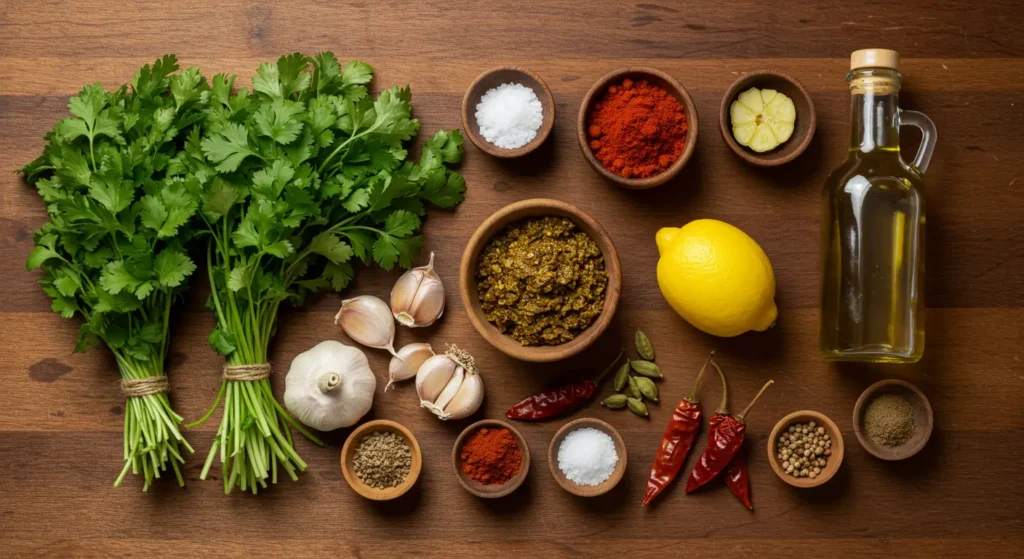
At its heart, Moroccan chermoula sauce is deceptively simple — a vivid blend of herbs, garlic, citrus, and earthy spices. But like every iconic Moroccan dish, its ingredients do more than flavor food. They restore balance. They carry memory. They heal.
This is not just any green herb marinade — this is the foundation of Moroccan coastal cooking. From Essaouira to Agadir to Casablanca, this chermoula recipe reflects generations of flavor know-how passed down in Moroccan kitchens.
Ingredient List (For Authentic Moroccan Chermoula)
- 1 bunch fresh cilantro, finely chopped
- 1 small bunch fresh flat-leaf parsley, finely chopped
- 4–5 cloves garlic, crushed or grated
- 1 teaspoon ground cumin
- 1 teaspoon sweet paprika
- ½ teaspoon ground coriander (optional but traditional in Fassi-style chermoula)
- ¼ teaspoon cayenne pepper (optional for mild heat)
- Juice of 1 lemon (or 1 preserved lemon pulp for traditional Moroccan depth)
- ⅓ cup Moroccan olive oil (extra virgin if possible)
- Salt to taste
- 2 tablespoons water (optional — to thin if using as a dressing)
Flavor Tip: Toast cumin and coriander seeds briefly before grinding for added depth.
Regional Twist: For a coastal-style chermoula sauce, add turmeric and a touch of harissa paste.
Where to Find Authentic Moroccan Ingredients
If you live outside Morocco, sourcing authentic ingredients is key to the real taste of chermoula sauce:
- Preserved lemons: Look for them in Middle Eastern or North African groceries
- Moroccan olive oil: Go for unblended, cold-pressed varieties
- Fresh herbs only: Dried substitutes won’t deliver the same bright, herbal punch
Healthline – Olive Oil Benefits
Moroccan Foodie – Guide to Moroccan Preserved Lemons
Can I make Moroccan chermoula without cilantro?
Yes — but you’ll lose that signature boldness. Parsley alone works in a pinch, but for more complexity, try mixing parsley with fresh mint or even a dash of za’atar. It won’t be the classic Moroccan version, but it’ll still be herbaceous and flavorful.
How to Make Moroccan Chermoula Sauce (Step-by-Step)
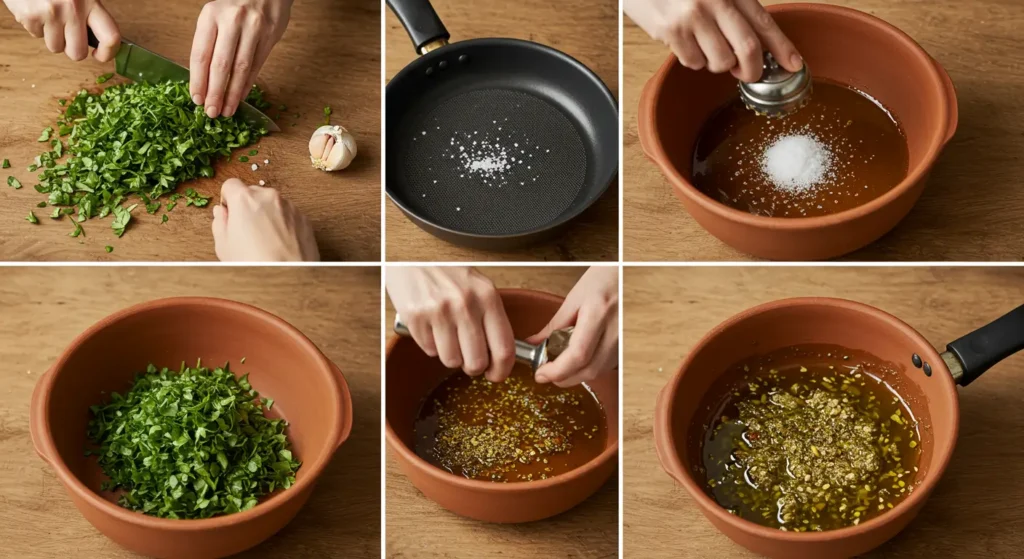
Making Moroccan chermoula sauce isn’t just a kitchen task — it’s a rhythmic, almost meditative ritual. In Moroccan homes, this bold herb-and-spice blend is often passed from generation to generation, made with quiet focus and deep familiarity. Whether you’re pounding garlic in a stone mortar (mehraz) or pulsing ingredients in a modern blender, the method itself infuses soul into the sauce.
Here’s how to craft it — the way it’s been made for decades from Agadir to Fes.
Step-by-Step Instructions
1. Prepare the herbs.
Rinse the cilantro and parsley thoroughly to remove grit. Dry completely, then chop by hand or give a few pulses in a food processor. Avoid turning it into mush — chermoula sauce should be textured and fresh, not pureed like soup.
2. Crush the garlic.
Using a mortar and pestle (mehraz) or the side of a knife, crush garlic cloves with a pinch of salt. This Moroccan method releases oils that soften garlic’s bite and form a rich paste — the flavor foundation of any proper North African marinade.
3. Combine the dry spices.
Mix cumin, sweet paprika, ground coriander, and cayenne. Toasting them lightly in a dry skillet enhances their aroma and brings out the smoky warmth essential to traditional Moroccan cooking.
4. Add lemon and olive oil.
Stir in fresh lemon juice or the pulp of preserved Moroccan lemon for that tangy, salty depth. Drizzle in high-quality Moroccan olive oil while whisking — this forms the lush, golden base of the sauce.
5. Blend it all together.
Combine the chopped herbs, garlic paste, spice blend, lemon, and oil. Use a bowl and wooden spoon, or gently pulse in a food processor.
- For a marinade: Leave it coarse and green.
- For a dipping sauce: Go smoother, but never fully liquid.
6. Taste and rest.
Adjust salt, lemon, or herbs as needed. Let your chermoula sauce sit for 15–30 minutes to allow flavors to fully infuse — a Moroccan secret for depth and balance.
Texture Tip — Mortar vs. Blender
Modern: A food processor gets the job done faster, but don’t overdo it. You want rustic charm, not baby food consistency.
Traditional: The mehraz (mortar and pestle) yields a rustic, earthy paste full of character. Perfect for grilled fish or lamb.
Chermoula Sauce Variations by Region
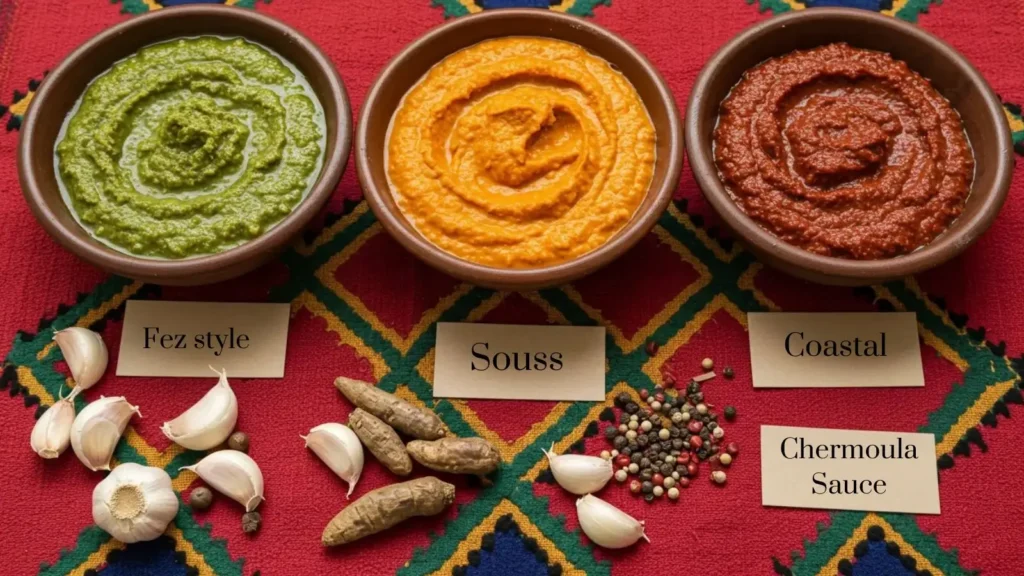
Chermoula sauce isn’t just one recipe — it’s a reflection of Morocco’s culinary diversity, shaped by landscape, tradition, and taste. From the scholarly kitchens of Fez to the windswept shores of Essaouira, this iconic herb-and-spice sauce shifts its character to match its region.
The base — garlic, fresh herbs, warm spices, and citrus — remains familiar. But as you’ll see, each Moroccan region has infused this sauce with its own story, flavor, and soul.
Fassi Style (Fez)
Elegant. Herbal. Subtle.
- Uses less oil, favoring acidity from lemon or vinegar
- Prioritizes parsley over cilantro
- Minimal spices, often no paprika
- A touch of grated onion adds depth
- Often paired with vegetables or white fish
This version of chermoula sauce feels like it belongs in an old Moroccan riad — understated, refined, and timeless.
Soussi Style (Souss Valley / Amazigh Region)
Bold. Rustic. Deeply rooted.
- Heavily garlicked and full of punch
- Sometimes made with argan oil or red chili
- Smoother in texture, ideal for meat stews and hearty tagines
- Spices like cumin and turmeric play a central role
This is the kind of Moroccan chermoula sauce that grabs your attention — intense, earthy, and unmistakably Amazigh.
Coastal Red Chermoula (Tangier, Essaouira)
Colorful. Smoky. Seafood’s soulmate.
- Deep red color from paprika and sometimes tomato paste
- Perfect for grilled sardines, sea bass, or roasted mackerel
- Balanced salt, lemon, spice — plus preserved lemon for tang
- Harissa often joins the mix for added warmth
If there’s one chermoula sauce that feels made for the Atlantic breeze, it’s this one.
Why These Variations Matter
Each version reflects a corner of Moroccan identity:
- Fez: calm, scholarly restraint
- Souss: fierce, ancestral warmth
- The Coast: bold, ocean-kissed brightness
Learning about these variations isn’t just a culinary lesson — it’s a window into Morocco’s spirit, served by the spoonful.
Which chermoula sauce is considered most traditional?
There’s no single answer. All are authentic to their regions. But if you’re craving that deeply rooted, widely loved flavor served at Moroccan street grills and family fish roasts, the coastal red chermoula sauce is your must-try.
How to Use Chermoula Sauce Like a Moroccan
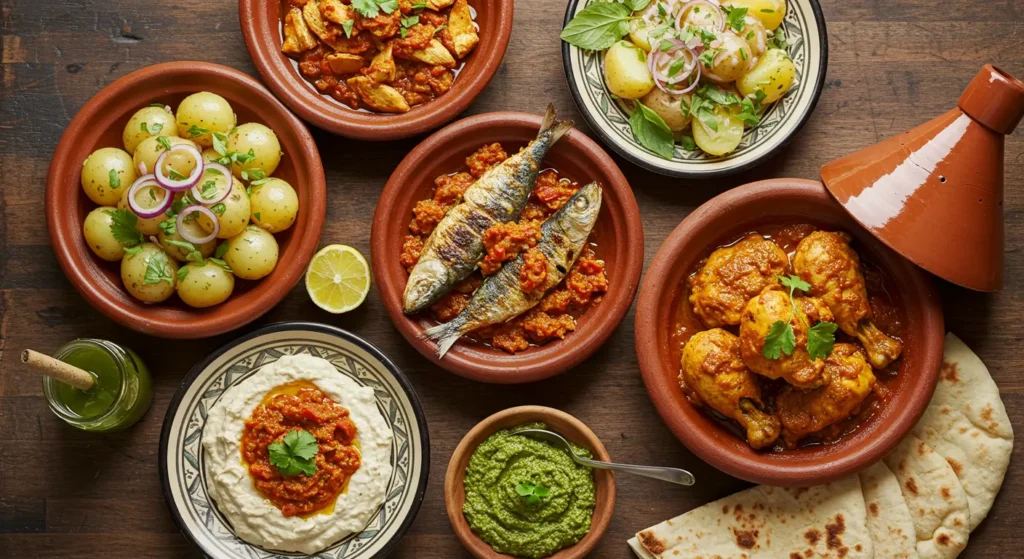
In Morocco, chermoula sauce is more than a condiment — it’s a starting point. A whisper of what’s to come. We don’t drizzle it randomly over meals like some trendy sauce. No. We marinate, we stuff, we layer, we bake. It’s part of the food’s story, not just its topping.
This is how we really use chermoula sauce — not in Pinterest-perfect kitchens, but in homes filled with steam, scent, and the quiet clatter of metal pots.
1. As a Marinade for Fish (Hout Mchermel)
- Rub sardines, seabass, or mackerel with a bold coat of chermoula sauce
- Let it rest for 30 minutes to overnight
- Grill, roast, or pan-fry
- Bonus move: layer with tomato, potato, and green pepper before baking
Hout Mchermel is a love letter to coastal Morocco — meant to be torn into by hand, not served with silverware.
2. Baked into Tagines
- Spoon it over onions at the base of your tagine
- Works beautifully with chicken, lamb, or roasted vegetables
- Add under the meat — so the steam brings out its full aroma
- Finish with a spoonful just before serving
This is where Moroccan chermoula becomes perfume — scenting the dish from the inside out.
3. Mixed with Potatoes or Carrots
- A classic Friday lunch side
- Mash boiled potatoes with warm chermoula, olive oil, and lemon
- Serve as a cold mezze, or warm with fresh khobz
The simplest dish on the table — and always the first to vanish.
4. As a Spread or Dip
- Use thicker chermoula sauce as a rustic spread on bread
- Serve with olives, preserved lemon, or anchovies
- Blend with yogurt or tahini for a silky dip with grilled meats or veggies
No need for a main course. Sometimes, bread and boldness is all you need.
Can I use chermoula sauce on non-Moroccan dishes?
Absolutely. This versatile herb marinade works wonders outside its origin. Try it on:
- Grilled shrimp or prawns
- Roasted cauliflower or eggplant
- As a marinade for tofu or halloumi
- Drizzled over couscous or whole grain bowls
Once you taste it, chermoula sauce doesn’t just stay Moroccan — it becomes part of your kitchen story too.
USDA FoodData Central – Fresh Herbs
Tips & Tricks from a Moroccan Kitchen
Anyone can follow a recipe. But real chermoula sauce? That lives in the details — the little gestures, the intuitive tweaks, the “my mom always said…” kind of magic.
These aren’t secrets you’ll find on packaging. But they’re what elevate your homemade Moroccan marinade from decent to unforgettable.
Tip 1: Toast Your Spices — Even Just a Bit
Toasting cumin, paprika, and coriander for just 30 seconds in a dry pan transforms the base of your chermoula sauce. Smokier. Deeper. Warmer.
The scent alone will make your kitchen feel like a spice market.
Tip 2: Crush Garlic With Salt
Don’t mince. Crush garlic with coarse salt until it turns paste-like. This base melts into herbs and olive oil, giving your herb paste a silky body and balanced heat.
Bonus: Salt tones down bitterness while pulling out the sweet garlic oil.
Tip 3: Preserved Lemon Is a Must (If You Can Find It)
Fresh lemon is nice. But preserved lemon? That’s old-city funk — salty, citrusy, and deeply Moroccan.
- Use the pulp for smooth texture
- Add the rind too for bold flavor in your chermoula sauce
This ingredient alone can make or break the sauce’s soul.
Tip 4: Make a Big Batch and Freeze It
Freeze your chermoula in ice cube trays, then store them for later. Great for:
- Roasted vegetables
- Tagines
- Lentil stews
- Scrambled eggs
One cube = instant flavor upgrade. No store-bought marinades needed.
Tip 5: Let It Sit — Time Is Flavor
Like many North African condiments, chermoula sauce develops more depth if left to rest. 20–30 minutes lets the herbs relax, garlic mellow, and spices bloom.
Make it early. Let it settle. Your tagine will thank you.
Can I store chermoula in the fridge for a week?
Technically yes, but after 3–4 days the flavor fades. For better shelf life:
- Cover with a layer of olive oil
- Use a clean spoon each time
- For longer storage, freeze in small portions
Remember, even traditional Moroccan sauces can use a little modern help in storage.
Substitutions and Allergy-Friendly Swaps for Chermoula Sauce
Let’s face it: not everyone has access to preserved lemons or is on board with cilantro. But that doesn’t mean you have to miss out on the soul of chermoula sauce. It just means we take a few Moroccan-style detours to get there — and still deliver the flavor punch.
Here’s how to adapt without losing the essence of this iconic North African herb marinade.
1. No Cilantro? Use Parsley + Mint
Cilantro has a love-it-or-hate-it flavor. If you’re in the second group:
- Double the parsley
- Add a tiny pinch of mint or dried za’atar for sharpness
Not classic, but still deeply herbal and delicious.
2. No Preserved Lemons? Try This Hack
Preserved lemons take weeks — but this shortcut gets close:
- Mix lemon juice + zest + a pinch of sea salt
- Let sit 10–15 minutes before using in your chermoula sauce
You won’t get the full funk, but you’ll capture the brightness.
3. Garlic Allergy? Try Roasted Garlic Oil
Infuse olive oil with roasted garlic cloves for a gentler, sweeter base.
Garlic powder works in a pinch, but lacks depth.
4. Spice Sensitivity? Soften the Heat
If cayenne or paprika is too much:
- Use sweet smoked paprika
- Swap cayenne for Aleppo pepper or sumac
The goal of traditional Moroccan chermoula sauce is balance — not burn.
Can I make an oil-free chermoula?
Yes — but it won’t be the traditional version passed down in Moroccan households.
Use alternatives like:
- Aquafaba (chickpea water)
- Tahini (adds creaminess)
- Low-sodium broth for lighter texture
You’ll lose the silkiness, but it’s a fair trade if needed.
Author’s suggestions
Turkey Recipes 8 Flavorful Dishes for Every Occasion
Conclusion: A Sauce, A Story, A Bit of Home
If you’ve made it this far, you’ve probably realized: chermoula sauce isn’t just a recipe. It’s a quiet celebration of Moroccan identity — spooned into fish tagines, folded into memories, passed silently from kitchen to kitchen like a fragrant secret.
Maybe you came here looking for a quick condiment.
But what you’ve discovered is an invitation — to cook like a Moroccan, to season with soul, and to see food as a bridge between generations.
So the next time you crush garlic with salt, or drizzle olive oil over fresh herbs, remember: you’re not just mixing a sauce.
You’re preserving a tradition.
Now it’s your turn:
- Try the recipe
- Make it your own
- Share it with someone who deserves it
And if you feel a little more connected, a little more nourished — then that’s exactly what chermoula sauce was meant to do.
Disclaimer: This article is provided for informational purposes only and is not a substitute for professional medical advice, diagnosis, or treatment.
For any health-related questions, please consult a qualified healthcare professional.
Chermoula Sauce FAQs
Is chermoula sauce spicy?
Usually no. Moroccan versions are known for their herb-forward flavor, not fire. But you can add heat with:
Cayenne
Harissa
Fresh chili
Or keep it mellow with just paprika and cumi
What’s the difference between Moroccan and Tunisian chermoula?
Moroccan chermoula: fresh herbs (parsley, cilantro), lemon, olive oil
Tunisian version: includes dried fruits, onions, more harissa
Moroccan chermoula sauce is brighter and herbier — better as a marinade or table sauce.
Can I freeze chermoula sauce?
Absolutely:
Freeze in small cubes
Store in freezer bags for up to 2 months
Ideal for quick flavoring — soups, tagines, or roasted vegetables
What dishes go best with chermoula?
Classic Moroccan pairings:
Grilled sardines
Chicken or fish tagines
Roasted carrots or potatoes
Flatbread with olives or anchovies
Also amazing on eggs, rice bowls, and sandwiches.
Can I make a dry version of chermoula?
Yes — Moroccan cooks do it all the time:
Dried parsley or cilantro
Garlic, cumin, paprika
Lemon juice and a drizzle of oil or broth
Perfect as a quick rub or dry marinade base.
Tell us about your experiences!
There are no reviews yet. Be the first one to write one.


